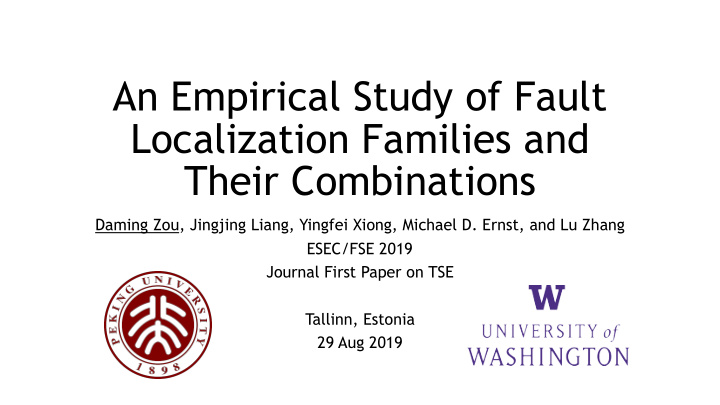



An Empirical Study of Fault Localization Families and Their Combinations Daming Zou, Jingjing Liang, Yingfei Xiong, Michael D. Ernst, and Lu Zhang ESEC/FSE 2019 Journal First Paper on TSE Tallinn, Estonia 29 Aug 2019
Fault Localization (FL) • Automated Fault Localization • Using static and run-time information to locate the root cause of failure. • E.g., test coverage, program dependency, test output, etc. • Typical output, a ranked suspicious list: foo.java, line 12 foo.java, line 10 (Bingo!) bar.java, line 5 ...
Fault Localization Families FL Family Information Source Spectrum-based (SBFL) Test coverage information Mutation-based (MBFL) Info from mutating the program (Dynamic) Slicing Dynamic program dependencies Stack trace analysis Stack trace when crash Info from mutating the results of conditional Predicate switching expressions Information retrieval-based (IR-based) Bug reports History-based Development history
Motivation • Existing studies focus on comparison within family: Ochiai(SBFL) vs. DStar(SBFL) vs. Tarantula(SBFL) vs. … • This study tries to understand the correlation of different families on real-world dataset. In terms of both effectiveness and efficiency. Performance Run-time cost SBFL ? ? MBFL ? ? etc. ? ?
This empirical study… • Covered a wide range of FL techniques from 7 families. • Based on 357 real-world faults from Defects4j dataset. • Proposed a combined technique that significantly outperforms all existing techniques.
Research Questions • RQ1: How effective are the standalone FL techniques? • RQ2: How much are these techniques correlated? • Reveals the possibility of combining them. • RQ3: How effectively can we combine these techniques? • RQ4: What is the run-time cost of standalone and combined techniques?
Experimental Subjects • Defects4j dataset • 5 real-world and widely-used projects. • 357 actual faults. • Average size of projects: 138,000 lines of code.
RQ1. Effectiveness of Standalone Techniques • Top n : How many faults can be localized within top n positions. • The effectiveness differs significantly between families. • Spectrum-based FL is the most effective family.
RQ1. Effectiveness of Standalone Techniques • Stack trace analysis is the most effective one on crash faults .
RQ2. Correlation between Techniques • 55 pairs of techniques in total. • Only 2 pairs are significantly correlated. - Ochiai(SBFL) / Dstar(SBFL) - Union(Slicing) / Frequency(Slicing) • Most techniques are weakly correlated, including all techniques in different families. • Possibility to utilize the potential complementary information.
RQ3. Effectiveness of Combining Techniques • How to combine? Learning to Rank. • First introduced to FL by Xuan & Monperrus[1]. • Standalone techniques are treated as a black box. • Output: One re-ranked suspicious list. • Example: foo.java line 12: {Ochiai: 0.6, slicing: 0, MUSE: 0.3, …} foo.java line 10: {Ochiai: 0.5, slicing: 1, MUSE: 0.3, …} bar.java line 5: {Ochiai: 0.4, slicing: 1, MUSE: 0.4, …} [1] Xuan, Jifeng, and Martin Monperrus. "Learning to combine multiple ranking metrics for fault localization." 2014 IEEE International Conference on Software Maintenance and Evolution . IEEE, 2014.
RQ3. Effectiveness of Combining Techniques • The combined technique significantly outperforms any standalone technique. CombineFL Results. Comparing to Best Standalone Techniques. Best Standalone CombineFL 205 168 156 137 111 84 72 24 Top 1 Top 3 Top 5 Top 10
RQ3. Effectiveness of Combining Techniques 30 IR-based • Contribution: decrease when 23 Predicate Switching 20 Standalone remove from the combination. 20 15 10 • The contribution of each 3 3 technique to the combined 0 0 0 0 results is not determined by its Top 1 Top 3 Top 5 Top 10 effectiveness as a standalone 12 IR-based technique. Predicate Switching 9 Contribution 6 3 0
RQ4. Time Consumption and Combination Strategy (in seconds) • FL families can be categorized into levels. • The run-time differs in orders of magnitude between levels.
RQ4. Time Consumption and Combination Strategy • How to select FL techniques for combination: • Select an acceptable time level. • Include all preceding level families.
Implications • Call for more information sources. • Evaluating a FL technique: • It is important to know its contribution to the existing combinations. • Both effectiveness and efficiency are important. • Our infrastructure available at: https://combinefl.github.io/ • Standard JSON format. • Automated integrating your FL technique with all aforementioned techniques.
Recommend
More recommend